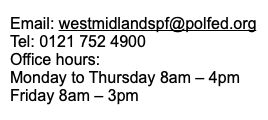The Force sets annual attendance targets and uses these calculations to identify trigger points for managing attendance at work. This aims to enable the Force to identify concerns at an early stage and take supportive, and informal, action to help officers achieve improved and acceptable attendance.
The trigger points are eight working days, or three occasions of absence, calculated over a rolling 12-month period.Long-term absence is recognised as one period exceeding twenty eight days.
Absence
If a particular pattern of absence is evident - including part day absence - this may also be regarded as a trigger.
ASMs are part of the informal procedure. If absence levels are equal to, or greater than the attendance triggers, a line manager may invite the member to an ASM, to discuss absences from work along with objectives, actions, support and interventions that will help improve attendance or facilitate a return to work.
“We always advise officers to check that they are being asked to attend an ASM and that they are not facing Stage 1 of the attendance policy,” says Julie. “As the ASM process aims to be supportive, it is expected that in all but exceptional circumstances contact will be made directly between the member and their line manager, however, a Federation representative or workplace colleague may facilitate discussions regarding meeting arrangements.
”Meetings will be held on Force premises where possible or alternatively at home or an alternative location. Often they are now held via Skype or Teams. The member should obtain necessary medical evidence to place a duty on the Force to implement reasonable adjustments.
If they have a Reasonable Adjustments Passport (RAP) in place this should be up to date and be highlighted.
“Meetings are not intended to imply absence is not genuine; this is a tool to support members in achieving acceptable and sustained attendance at work,” Julie explained. “The approach appropriate for everyone will be considered from the outset, and throughout a period of absence to ensure that this is individual to their needs.
Occupational health
“Interventions could include referral to occupational health, exploration of reasonable adjustments, signposting, temporary restrictions or management support.”
Actions agreed at an ASM will be documented in a wellbeing plan with a review period set. For short-term absences, this is usually three to six months but, with longer-term absences, they may be sooner dependant upon the circumstances.
If a development or wellbeing plan is initiated it must be SMART (specific, measurable, achievable, realistic and timely). Although rare, failure of this can technically result in moving to the formal stage of the Unsatisfactory Attendance Process so it is vitally important plans are suitable.
Of course, should there be further absences during the review period, or a return to work is not achieved, a further meeting will be held. A determination will be made at this point as to whether to continue with ASMs at the informal stage, or to move to the formal process.
“While this is informal and aims to be supportive, it still forms part of the attendance policy and evidence of non-attendance or a reluctance to look at resolutions will be noted and can be used in future more formal stages,” Julie pointed out.“I would advise anyone faced with an ASM to contact the Federation for early support and reassurance. But, just to repeat, do not panic!”



















